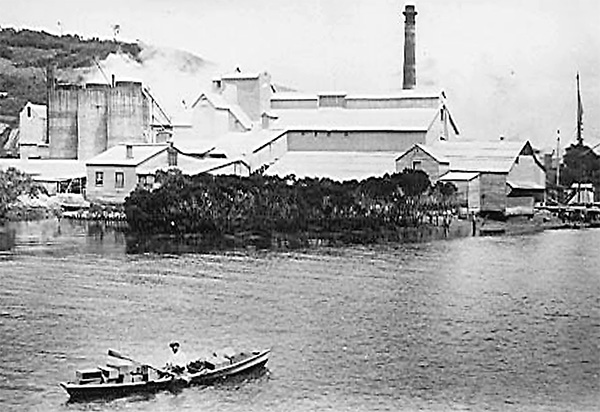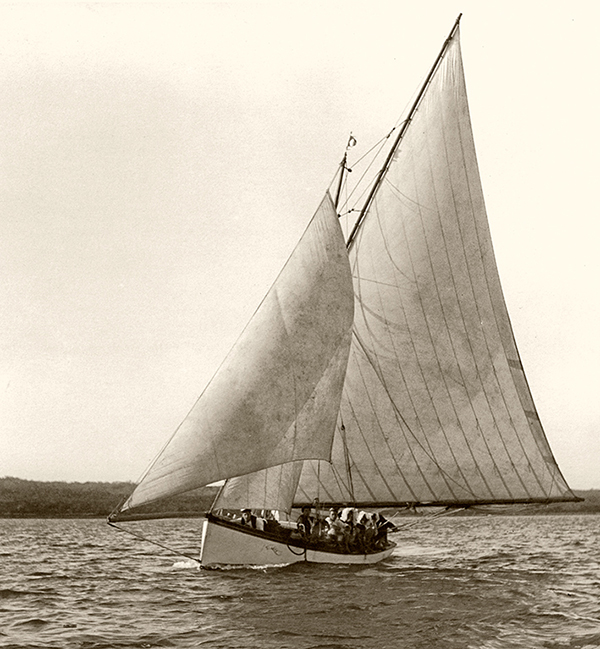Jade River: A History of the Mahurangi
Ronald H LockerFirst published 2001. Published online 2014–. This online edition is a work in progress…
Pages 175–178in printed edition
Extraordinary Mahurangi rowers

Rowing in the Industrial Age: Although the Industrial Revolution occurred a century earlier, the lack of all-weather roads caused Mahurangi settlers to rely on the four-millennia-old technology of rowing, for much of their transport needs. Here William Hamilton rows towards Warkworth, past the Wilson Cement Works in the distinctive Mahurangi punt. image Jade River: A History of the Mahurangi
Importance of good rowing boats to the settlers is emphasised in the previous chapter. A number of rowing stories survive which deserve inclusion here. In these days when most boatmen appear to need an outboard to get from the beach to their mooring, it is salutary to remember that Mahurangi settlers were made of much sterner stuff.
One of the characters of early Waiwera was Pat Lennon, a big and powerful man, who never wore boots, and could strike matches on his soles. He took out fishing parties, and also ran a ferry service from Waiwera to Kawau Island at two shillings to three shillings a head. He used a 22-foot boat, which he always rowed standing up, with 14-foot sweeps. It took him about four hours to row the seven miles.
During the 1860s the mails were rowed from Ōrewa to Warkworth. This would have been a fair pull on a fine day, but keeping to a schedule must have meant many journeys that were sheer hell.
Journeys on or about the harbour and river were usually in the Mahurangi punts. Although not of epic scale, remembered tales serve to show the physical demands of getting about, in the course of lives that were already strenuous enough. The rowers used the flow of the tide as far as possible and put up a small sail in a following wind, but a head wind and a contrary tide meant hard labour.
The first steamer service ran only to the Heads, involving long rows for settlers nearer Warkworth. Joseph Gard records in his diary of 1856, rowing in his dinghy from Exe CreekDuck Creek to join the Wonga Wonga at Scotts Landing, and being picked up by his mate in the same way on his return. The Rose Casey ran up the Mahurangi River if the tide allowed, but seems to have operated to a fixed timetable, rather than to the tides, as in later days. Two young ladies visiting the Dugald Morisons at Hepburn Creek in 1888, wrote of being picked up by their host at Scotts Landing on arrival, and on departure, rejoining the Rose Casey below Grants IslandMotukauri.

Iron Man’s Cruel Irony: Given the manifest productivity and humanity of the man, it is harsh that one of the few mentions of prolific mullet boat builder and champion rower James Clare, is in relation to a police charge of failing to care for his apparently undeserving father. image Boating New Zealand
Gard’s diary records a long day’s outing from Duck Creek in his dinghy. On 23 September 1856, he and two other young men:
…started at six in the morning for the Hot Springs—distant nine miles – got there about one o’clock—found the party had left that used to be there—dined at Scotts’ and got home about eight o’clock being very dark.
The Reverend McKinney, who took up his post at Warkworth in 1856, had to row downriver to the Mahurangi Harbour to conduct services fortnightly, in the afternoons—he also ranged on horseback as far as Waipu. He was a strong man, and needed to be. As his large family grew up, he was able to relax a little and let his sons do the rowing. One of them said with irony in later life:
Six days shalt thou labour and do all thy work. On the seventh thou shalt row thy father to the Heads and back, with or against the tide.
To make matters worse the diligent pastor was given to paying calls on parishioners up side creeks, thus adding to the mileage.
When my grandfather owned Cowans Bay, he worked the timber there, cutting kauri and hauling it with his bullocks. He would row the four miles from his home in the far corner of Huawai Bay, and stay in a shanty, going home in the weekends. But in later years when he was cutting the mānuka for firewood, he rowed up and down each day. With an adverse wind or tide, it must have been a weary journey after a day working with an axe.
Peter Anderson used to supplement the meagre returns from his small holding by working at the cement works, for six shillings a week. This was common at that time. My cousin remembers seeing half a dozen worker’s punts tied up by the cement wharf. Peter was a Swede, who at 22, had jumped his British ship, the Thyatira, in Sydney in 1872, and found his way to Aotearoa. He would row from his home near Schoolhouse Bay to the works each Monday, taking enough of his wife’s girdle scones to see him through the week in his shanty. On Friday nights, he rowed home for the weekend. There was a famous occasion when he hitched a ride home in the steamer, tying his punt on behind. Unfortunately, the steamer hit the mud and had to back off. Someone remembered the punt behind. Peter hastened aft, saying ‘She’ll be right’, but when he hauled in the painter, he found to his dismay that it was attached only to the ringbolt from the stem. The screws had sucked in his dory and reduced it to matchwood. Peter was noted for the fluency of his swearing, a legacy of days before the mast, although I’m told he had converted to swearing in English. On this occasion he excelled himself. Amusing to us, the incident would have been no joke to a man dependent on a boat for his livelihood.
Another man who commuted in the same way to the works, had worse luck. George Warin of Te Kapa also spent the weekends at home. On one such journey he was saving his energy with the sail, when a gust of wind capsized him off Cowans Bay. Like many men of his time, he could not swim, and drowned. His young widow, Marthanée Quinn , three-years wed, later married William McElroy.
In the 1890s, Charles Emtage had a contract to provide the firewood consumed by the stoves and fireplaces of Rodmersham. He presumably cut this on Motuoraan island; motu = island, where he lived, and rowed it across once or twice a week. I can remember rowing a punt loaded with manuka a much lesser distance in sheltered water, and it was a heavy slog. But Captain Emtage was a hardened rower. He used to fish from his mullet boat outside the Mahurangi Heads and take his catch to Warkworth. On one occasion when becalmed out towards Tiritiri Matangi Island, he set out to row to Warkworth before his catch spoiled. The mullet boat, as was common in that time before engines, had tall bronze rowlocks which stood up above the coamings, allowing the use of big sweeps—the boats were rowed in a circle, while netting. He met up with two men rowing a dory off the heads, and paced them up-river to the “corner stake”, where the mangroves close in. The pair here gave up the contest, leaving Emtage to continue to Warkworth. On another occasion, when in command of a coastal trader, the ship anchored off Tiritiri Matangi for the night. The captain rowed across to Motuora to spend the night with his family.
Likewise, my great-uncle, George Jamieson, was skipper of the scow Thistle. When it was tied up at the Motutara quarry wharf while loading gravel, he rowed home in the evening to Jamieson Bay to spend the night with his family and rowed back next morning.
Thomas Wilson told of a journey from Warkworth to Motutara to collect rounded beach stones for the tube mill, which ground the cement. He set out in the first local petrol launch, which broke down about halfway down River. While the owner tinkered unsuccessfully with the engine, Thomas rowed the launch all the way to the island, aided by the tide. Fortunately, the engine fired for the return, laden with stones. I have often wondered how the cutters got up to Warkworth in the old days. I believe that they too used sweeps and the incoming tide. These stories of the hardened hands and muscles of old, are worth remembering today, when to row a kilometre is considered onerous.
The women of Mahurangi were no mean rowers. At the 1868 Mahurangi Regatta, five married women competed in punts, all completing a two-mile course in under 25 minutes, in an uncomfortable westerly chop. Eric Barker’s mother, while still a girl, would row from the head of the Pukapuka to Scotts Landing to collect the mail from the steamer.
I have saved for the last the most impressive rowing story of all: the exploit of James Clare, shipbuilder initially in the Mahurangi Harbour, and later at Auckland. The New Zealand Herald of 9 August 1866 reported:
Extraordinary Feat. — Mr James Clare, of the firm of Clare and Weymouth, boatbuilders, of Smales’ Point, being anxious to attend the death-bed of his brother-in-law, Mr John McGechie, at Mahurangi, and being becalmed off Heydon’s Island (Motuora) in the cutter Cornstalk, left that vessel about 5 o’clock yesterday morning, and pulled to McGechie’s at Mahurangi in her dinghy, a distance of at least seven miles. Found that his relative was dead, and the corpse had been taken to Auckland. He then determined to row to Auckland in order to be present at his friend’s obsequies; he therefore rowed to Shorts, could not get a boat there; rowed to Sullivan’s and there procured a flat-bottomed racing skiff. She is only about a foot deep, two feet wide at the bottom, and twenty-four feet long. In this frail and ticklish affair he left Mahurangi at 10 o’clock yesterday morning and pulled the wind (which was getting up fast) to [Whangaparāoa] Neck, hoping to get a cast across the isthmus for his boat in a cart, or bullock-dray, thus saving miles, but there was no such luck. He therefore started again and rowed through the Tiritiri Passage, the wind by then blowing pretty stiff. Sighted a schooner bound for Auckland, and pulled his hardest for about two hours to try to overtake her and get a tow, but could not attract her notice. Nothing daunted he pulled on and arrived at Smale’s Point, Auckland, at about 4 o’clock yesterday afternoon—the latter part of this wonderful performance in a gale of wind and sea that would have made the adventure a most dangerous one to any sculler was not so accomplished in the art as our champion. The distance Mr Clare sculled yesterday is at least 40 miles. This is surprising, but to those who know the kind of boat he came up in, and the weather he must have encountered, the skill and pluck displayed must appear truly astonishing.
But Clare was no ordinary rower. He was for nine years champion oarsman of New Zealand, and a life member of the Auckland Rowing Club. He won the Mahurangi Regatta rowing race in 1865. In 1864, he had built the cutter Sea Belle for his brother-in-law, John McGechie junior, who was its skipper—who was only 23 when he died, of tuberculosis.
The report omits to say whether Clare was in time for the funeral. It is to be hoped that such valiant effort was rewarded.
